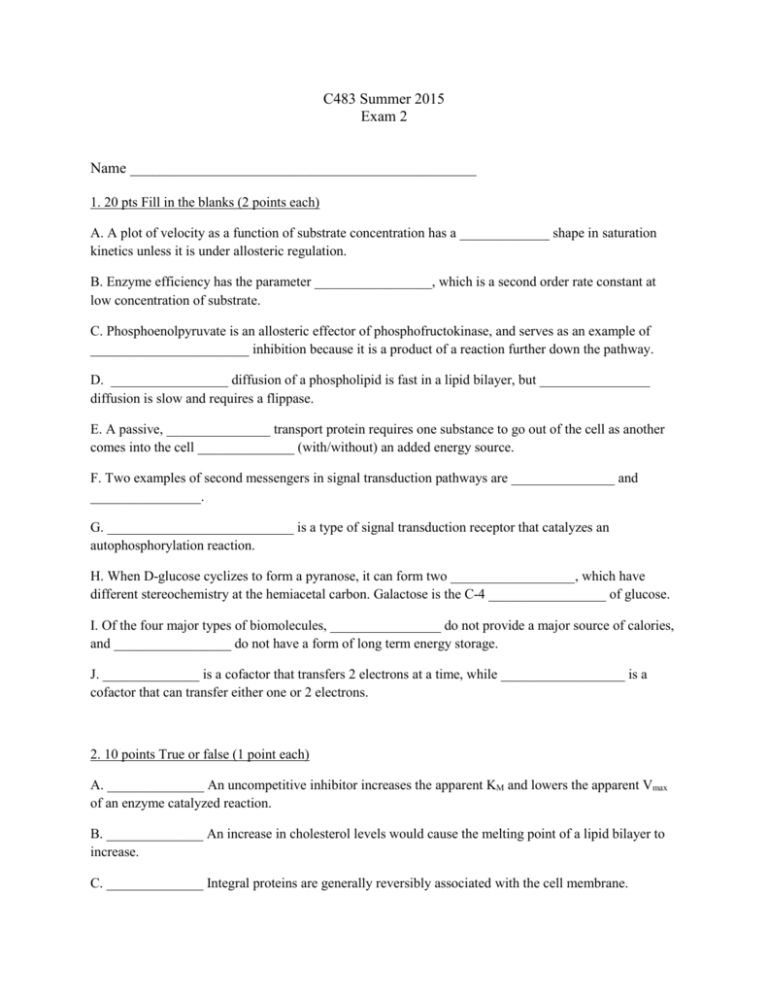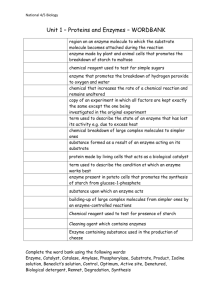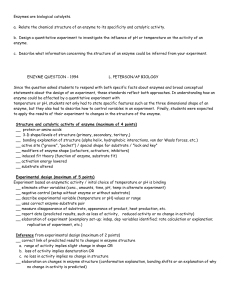Exam 2
advertisement

C483 Summer 2015 Exam 2 Name ______________________________________________ 1. 20 pts Fill in the blanks (2 points each) A. A plot of velocity as a function of substrate concentration has a _____________ shape in saturation kinetics unless it is under allosteric regulation. B. Enzyme efficiency has the parameter _________________, which is a second order rate constant at low concentration of substrate. C. Phosphoenolpyruvate is an allosteric effector of phosphofructokinase, and serves as an example of _______________________ inhibition because it is a product of a reaction further down the pathway. D. _________________ diffusion of a phospholipid is fast in a lipid bilayer, but ________________ diffusion is slow and requires a flippase. E. A passive, _______________ transport protein requires one substance to go out of the cell as another comes into the cell ______________ (with/without) an added energy source. F. Two examples of second messengers in signal transduction pathways are _______________ and ________________. G. ___________________________ is a type of signal transduction receptor that catalyzes an autophosphorylation reaction. H. When D-glucose cyclizes to form a pyranose, it can form two __________________, which have different stereochemistry at the hemiacetal carbon. Galactose is the C-4 _________________ of glucose. I. Of the four major types of biomolecules, ________________ do not provide a major source of calories, and _________________ do not have a form of long term energy storage. J. ______________ is a cofactor that transfers 2 electrons at a time, while __________________ is a cofactor that can transfer either one or 2 electrons. 2. 10 points True or false (1 point each) A. ______________ An uncompetitive inhibitor increases the apparent KM and lowers the apparent Vmax of an enzyme catalyzed reaction. B. ______________ An increase in cholesterol levels would cause the melting point of a lipid bilayer to increase. C. ______________ Integral proteins are generally reversibly associated with the cell membrane. D. ______________ Some gated channels can be opened and closed by membrane potential changes. E. ______________ A G-protein becomes active in a signal transduction cascade through the hydrolysis of GTP by its GTPase activity. F. ______________ Ribose may be considered to be an aldopentose. G. ______________ Lactose is not digestible by many human adults because they lack the necessary enzyme. H. ______________ A reaction with a negative biological standard free energy is spontaneous under all cellular conditions. I. ______________ Glyceraldehyde-3-phosphate, alanine, and pyruvate are all 3-carbon intermediates in metabolic pathways. J. ______________ When the same hormone causes two different responses in two different tissues through two separate receptors, it is called cross-talk. 3. (20pts) Short answer (5 points each) A. In a typical marine organism, the intracellular [Ca+2] = 0.1 M, and the extracellular [Ca=2] = 4 mM. Assuming a membrane potential of -70 mV, calculate the free energy change for calcium ion entering the cell at 20 oC using the given equation. In which direction would the calcium ion require active transport? B. A general schematic of the -andrenergic receptor mediated signal transduction pathway is given below. On the figure, label three points (using compounds particular to the -andrenergic receptor mediated signal transduction pathway) at which the signal transduction cascade is turned off, and how it occurs. C. Maltose is a disaccharide with an (14) linkage. Hydrolysis leads to two glucose monomers. Draw a structure for maltose (Haworth or chair.) D. Fill in any five blanks in this table concerning metabolic fuels in humans: Biomolecule carbohydrates proteins fats monomer Storage polymer -------------------- Fatty acid Digestive enzyme amylase Storage organ/cell ---------------------Adipose tissue Problems (10pts each) 4. A Lineweaver-Burk plot of a tyrosinase enzyme is shown below with and without inhibitor. A. Calculate Vmax for the enzyme with and without inhibitor. B. Does inhibitor cause the enzyme to apparently bind substrate tighter or looser? Explain why it does so. C. What type of inhibition is this? _______________________________ 5. Glucose is brought into the intestinal cell through secondary active transport through a symport protein with sodium ion. This process is linked to a Na+/K+ ATPase. Draw a schematic of the intestinal cell with its transporters, and give a short explanation of how glucose is brought into the cell against its concentration gradient. 6. A. COX is a key enzyme in the production of prostaglandins, which signal inflammation and pain responses. Assuming it follows typical Michaelis-Menton kinetics, draw a plot of reaction velocity as a function of substrate concentration. Draw it to scale assuming a KM value of 0.4 mM and a kcat = 3090 s-1. (In your experiment, the total enzyme concentration was 90 nM, or 90 x 10-9M.) B. Write the M-M equation, then use it to derive equations for the velocity of enzyme reaction at very low [S] and very high [S]. C. Aspirin inhibits COX, which catalyzes a reaction of arachidonic acid, by acetylating a Ser residue on the enzyme. Draw the reaction that shows how aspirin acetylates the Ser sidechain. D. Because aspirin is an irreversible inhibitor, it will react with some of the enzyme, lowering the amount of active enzyme, but not changing the apparent binding ability of the enzyme. Draw the same plot as in part A for the inhibited enzyme, and explain how it is similar and different than the part A plot. 7. The standard free energy change for the condensation of -D-mannose and inorganic phosphate to form -D-mannose-6-phosphate is approximately +14 kJ/mol. The standard free energy of ATP hydrolysis to ADP and inorganic phosphate is approximately -32 kJ/mol. A. Write the coupled reaction, with full structures of all compounds (You can write “A” for the nucleobase). B. What is the standard free energy change for the coupled reaction? C. What is the G when the [ATP] = 5 mM, [ADP] = 1 mM, and there is approximately 8 times as much mannose as mannose-6-phosphate? Show all work. 8. Would you expect these four reactions to have a positive, negative, or near zero standard free energy change? Circle the reaction you would expect to have the most negative value. ATP ADP + Pi 2 ADP AMP + ATP 9. (10pts Case study) The structure of vitamin K is shown below, in its reduced form. This vitamin is an essential cofactor for an enzyme that activates thrombin, a protease that induces blood coagulation. (Vitamin K was named after the word “koagulation” by the Danish scientist who discovered it.) In order for vitamin K to function in its catalytic role, it must be oxidized by the enzyme that activates thrombin. After thrombin is activated, the enzyme releases the oxidized vitamin K, which is re-reduced by the action of an enzyme called VKOR. This reduced vitamin K is then bound to the thrombin-cativating enzyme and re-oxidized while another thrombin is being activated. The full process is called the K cycle. A. Consider the structural similarity of vitamin K and coenzyme Q, then draw the 2-electron oxidized form of vitamin K. Would you expect vitamin K to act as a one- or two-electron transfer agent? B. Based on the amino acid sequence, VKOR is predicted to have 4 transmembrane -helices with the active site residues in the middle of the helices. Considering the structure of vitamin K, this protein structure prediction makes sense. Explain. C. Warfarin is a potent inhibitor of VKOR. It has been used as a rat poison and a human medicine. What physiological affect would a dose of warfarin have? Why does its dosage have to be monitored so closely when given to someone as a medicine? [𝑋]𝑓𝑖𝑛𝑎𝑙 G = RT ln[𝑋]𝑖𝑛𝑖𝑡𝑖𝑎𝑙 + ZF R = 8.314 J/ mol . K F = 96,485 J/V . mol









